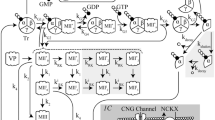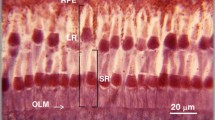Abstract
Using early receptor potential (ERP) measurements, we show that the bistable pigment in the barnacle photoreceptor behaves according to the conclusions of the preceding article (Hochstein et al., 1978): (1) The populations of both stable states approach their steady-state or “saturation” values under steady illumination exponentially with the same rate constant; the wavelength dependence of this rate constant is called the relaxation spectrum. — (2) The saturation values are independent of initial population and of light intensity; the wavelength dependence of the saturation population is called the saturation spectrum. — (3) The measured relaxation and saturation spectra agree with those calculated, by the theory of the preceding article, from the experimentally determined transition parameters of the pigment system. — We then demonstrate the applicability of relaxation and saturation measurements to the question of whether a single bi-stable pigment system serves, or two or more separate systems serve, as the origins(s) of the ERP and of other phenomena observed in the barnacle photoreceptor: The prolonged depolarizing afterpotential (PDA) and its depression and prevention (anti-PDA). By showing that the relaxation spectra for these phenomena match one another and that of the ERP, and that the same is true for the saturation spectra, we demonstrate that these phenomena originate from the same single bi-stable pigment system as the ERP.
Similar content being viewed by others
References
Cone, R.A., Pak, W.L.: The early receptor potential. In: Handbook of sensory physiology. Vol. I, pp 345–365 Loewenstein, W.R., ed. Principles of receptor physiology. Berlin-Heidelberg-New York: Springer 1971
Hillman, P., Dodge, F.A., Hochstein, S., Knight, B.W., Minke, B.: Rapid dark recovery of the invertebrate early receptor potential. J. Gen. Physiol. 62, 77–86 (1973)
Hillman, P., Hochstein, S., Minke, B.: Nonlocal interactions in the photoreceptor transduction process. J. Gen. Physiol. 68, 227–245 (1976)
Hochstein, S., Minke, B., Hillman, P.: Antagonistic components of the late receptor potential in the barnacle photoreceptor arising from different stages of the pigment process. J. Gen. Physiol. 62, 105–128 (1973)
Hochstein, S., Minke, B., Hillman, P., Knight, B.W.: The kinetics of visual pigment systems. I. Mathematical analysis. Biol. Cybernetics 30, 23–32 (1978)
Minke, B., Hochstein, S., Hillman, P.: Early receptor potential evidence for the existence of two thermally stable states in the barnacle visual pigment. J. Gen. Physiol. 62, 87–104 (1973)
Minke, B., Hochstein, S., Hillman, P.: Derivation of a quantitative kinetic model for a visual pigment from observations of the early receptor potential. Biophys. J. 14, 490–512 (1974a)
Minke, B., Hochstein, S., Hillman, P.: A photoreceptor sensitivity paradox. Biol. Bull. 147, 491 (1974b)
Author information
Authors and Affiliations
Rights and permissions
About this article
Cite this article
Minke, B., Hochstein, S. & Hillman, P. The kinetics of visual pigment systems. Biol. Cybernetics 30, 33–43 (1978). https://doi.org/10.1007/BF00365481
Received:
Issue Date:
DOI: https://doi.org/10.1007/BF00365481




